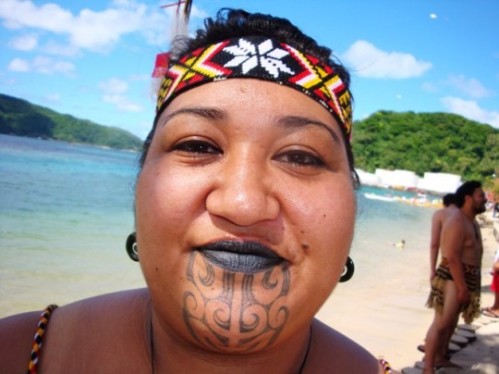I have for years ummed and ahhed about getting a tattoo. ‘Are you really sure?’ asked my mother when I told her that if I was going to get one whilst in New Zealand. With its Māori myths and history of tattooing, it seemed to be the logical and most honest choice. She was worried that I would regret it, wanted me to give it a proper think through. But that’s what mums do, right? Needless to say, I wasn’t angling for the facial Ta Moko, which on women was traditionally on their chin. I tried to imagine a future job interview with one of those.

Female Ta Moko (http://mypacificstory.com)
My research into the rituals and legends of Māori culture and tattooing started in Raglan, where I discovered the story of Mataora who was banished from the underworld for treating his wife badly, and told that his mission was to introduce ‘the art of tattooing to the world’ (1).
The first man who was actually tattooed is said to have been Tama (Tama-nui-a-Raki) whose wife ran off with another man. Feeling that this abandonment was a result of his own physical ugliness, he managed to persuade his ancestors to tattoo him, despite them telling him that the ‘the pain was as bad as death’. But he was adamant that they should ink him and it is said that ‘when his wounds healed, he found that he was handsome’. A somewhat happy ending, one would think, that may have resulted in the reunion of the couple (if his wife was really that shallow)? Nope. Legend says that he ended up killing his wife. I’m still trying to work out the morals of that story.
My own reason for wanting a tattoo was to mark a significant moment in my life: adventuring on my own, turning 30, and leaving behind the secure life that I had built up in the UK. This aspect fits with the idea of Māori tattooing which is linked to ‘rites of passage and important events in a person’s life’.
Making oneself attractive to the opposite sex is often cited as another reason that Māoris would decorate themselves, but this wasn’t my motivation. In fact, my own experiences tell me that many guys find tattoos on girls quite unattractive and when I discussed with some friends where on the body to get a tattoo, one guy simply said ‘don’t get a tramp stamp’, the popular bottom of the back marking. (I actually happen to think they look quite nice there. If tattooing is as addictive as people say, then maybe that’s where I’ll get my next one).
Māori tattoos typically tell a family and life story and have been used to identify the tribe to which they belong. I had read that some Māoris feel insulted that non-Māoris are tattooing themselves with Māori designs, that it is considered inappropriate.
When I asked Whetu of Westcoast Tattoos, New Plymouth, what his thoughts were on tattooing me, he was direct. ‘What I’m doing for you isn’t a true moko’, he said. Further research told me that it could be classed kirituhi – not a moko but a tattoo ‘inspired by Māori design’. I appreciated his honesty. I had been warned that there could be a few cowboys out there who would spin a yarn and draw me into some flawed and diluted historical context just to get the custom.
Traditional Māori art was kept to black, red and white; my tattoo would just be black. I wanted something modest. No faces or overly distinguishable shapes, just something simple incorporating typical Māori sprials (2). And I wanted it to flow. What Whetu decided to do for me was based on a koru spiral design that mimics the unfolding of ferns, a much more generic starting point which I had already seen in various forms on a few other people. And actually the koru was perfect for me, representing new life, regeneration, personal growth, strength and peace. A good choice. Thank you Whetu.
Having decided that I wanted it on my hip, Whethu drew the design free hand based on the shape of my body and my own likes and dislikes. The needling part prickled like a repeated mini bee stings but it came nowhere close to Tama’s experience, which is said to have been ‘long and terribly painful’ and where ‘he often fainted’ (1). There was no moto (blood) and at no point did I feel ānini (dizzy) (3). Whethu was gentle and skilful.
I wouldn’t say that it was a spiritual experience, but then I hadn’t gone through the whole process of fasting and preparation and other associated rituals, and ultimately my moko wasn’t and couldn’t be the real deal. But it wasn’t without spiritual significance and I found loveliness in the statement that a moko will help carry a person ‘ into any challenge, any task, and into a life fulfilled with a culture of their own’.
Whenever I look down at my new Māori inspired tattoo, I will remember this time in my life: the challenges and adventures and space to grow, the highs and the lows. One Māori saying reads: Taia o moko hei hoa matenga mou meaning Take your moko as a friend for life. I shall.
Sources: (1) Māori Myth and Legend, Orbell (2007), p111; (2) Māori Carving, Phllipps (1948); (3) He Pā Auroa A Dictionary and Language Guide for Students of Māori, Cormack (2001)





